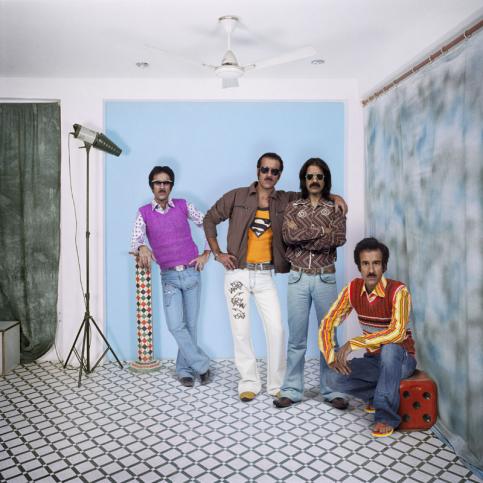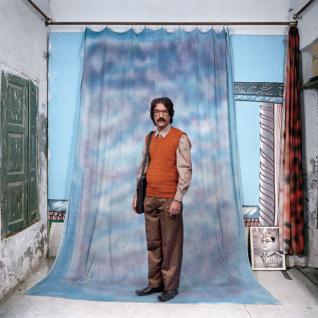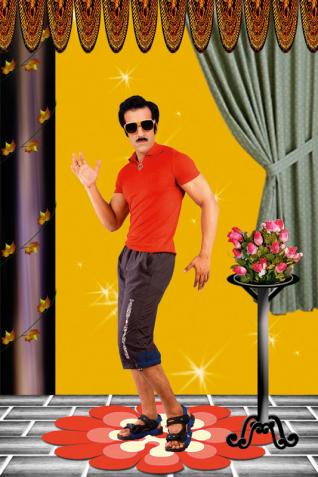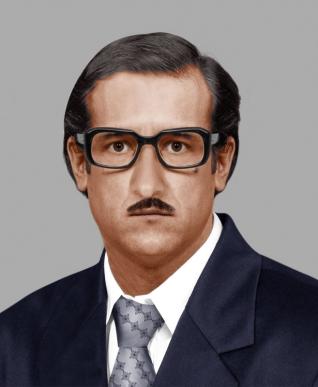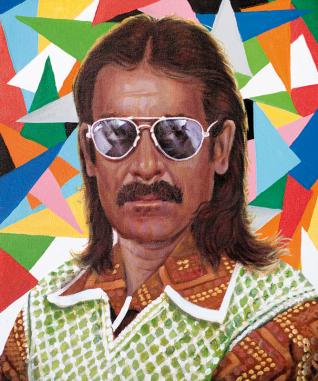Olivier Culmann presents us with a strange portrait gallery. The Indian man appears in many forms before our eyes without ever revealing his true identity…
Olivier Culmann began to shoot this series between 2009 and 2011, when he was living in Delhi, and kept shooting up until 2013. The Others will be presented in full for the first time at the Musée Nicéphore Niépce. In a series that includes over 130 photographs, the photographer questions the way in which social status is elaborated through the construction of self-image and explores the limits of the photographic medium.
The Others is an examination of the codes of Indian society and their modes of representation. The photographer’s basic material is a series of self-portraits. In each one, Olivier Culmann applies the visual and sartorial specifics that define each Indian to himself. In a society as compartmentalised as India’s, he means to highlight the variety of elements that make up the identity of an individual: religion, caste, class, profession, geographical origin…
The portraits are split in four phases, according to the different iconographic creative processes in India: neighbourhood photography studios, Photoshop used by digital labs, painting…
__
Phase 1: portraits taken in a photography studio
The studios represented in these shots are neighbourhood studios in different Indian cities, notably in Delhi and the surrounding regions, Chennai, Pondicherry and Mumbai.
__
Phase 2: portraits using digital equipment
In the neighbourhood studios, a range of backdrops is often available: a patterned curtain, a photographic mural or a landscape painted on the wall itself. When a client comes to have his or her photograph taken, they can also borrow various items of clothing (jackets, shirts, ties…) for the duration of the shoot. With the advent of digital technology, backdrops are easily created on the computer. The client, whose silhouette is cut out in advance, can thus choose the backdrop (reconstituted studio backdrop, Swiss mountain scape, Taj Mahal…) in front of which he or she wishes to be pictured.
Photographers also offer the option of the already well-dressed and well-presented headless body, on to which the client’s head can be attached and slid into place by the retoucher/photographer. Faceless bodies are also available (hair and ears are part of the package), as are various types of headgear (hats, berets, turbans…), hairstyles, various accessories (armchairs, couches, bouquets of flowers…) and frames with motifs.
The phase 2 portraits blend this digital material with the faces on the initial portraits.
__
Phase 3: recomposing and colouring damaged photographs
Repairing family photographs that have been damaged (by time, damp, ripping…) is common practice in India. It is often done when someone dies to restore an emblematic photograph of the deceased. The photo is usually seen on the wall at home or in the family business. It is a guarantee of filiation and its symbolic meaning seems more important than the actual faithful reproduction of the ancestor’s physical traits. In line with this practice, Olivier Culmann gave various digital retouching labs half a torn photo. He then asked them to reconstitute the face entirely and to colour the photo as they saw fit. Some added backdrops.
__
Phase 4: paintings from photographs
Painting on photographs is common in India, especially for shop signs and more traditionally for film posters. Using this skill set as a base, Olivier Culmann gave a Delhi painter a number of black and white photographs and asked him to paint them in different styles (mostly from film poster types). Just like with the repair work, he let the painter choose the backdrops and the colours.
The original paintings will be on show in the exhibition.
__
Olivier Culmann
The Others
This exhibition was co-produced with Tendance Floue and Central Dupon Images.
With support from Canson, Olympus France, La Souris sur le gâteau and the Hôtel St Georges in Chalon-sur-Saône.
All of the photographs for this exhibition were printed on Canson gloss 310g premium paper in the laboratory at the Musée Nicéphore Niépce.
A tie-in book is available from Editions Xavier Barral.
Publication /
The Others
Olivier Culmann
Editions Xavier Barral
Bound & covered
21.5 x 26.3 cm
196 pages
Approx. 140 colour photographs
Texts: Christopher Pinney, lecturer in anthropology and visual culture at London’s University College, François Cheval, Director of the Musée Nicéphore Niépce and Christian Caujolle, Associate Lecturer at the Ecole Nationale Supérieure Louis Lumiere, critic, independent curator.
__
Extracts:
Clothing oneself is no longer a functional necessity for humans, and has not been since time immemorial. The act of clothing oneself has transmuted into a game ruled by social convention. Appearance decides, even configures the real. The fictional lives that follow one another in the New Delhi studio are no more illusory than the “real” pseudo-images that come before. Faced with these decorated scenes, the only “incontestable”’ objects, we rediscover the consistency of likelihood. By playing with pretending, the photographer exhumes the weight of destiny that covers us. The shapes, colours and textures are all signals we address to our peers; the ones we want to stand out from! Faced with the inevitable, we put on the rags and adopt the attitude that others have determined for us.
Each photograph, or more to the point, each scene, is an event that is both derisory and perfectly apt. The portraits compose a collection of short stories. They do not pretend to reduce the different components of the Indian population to farce, but merely to reflect the spirit of the times. In the harsh light of the studio, these reconstituted lives rise above a reality that is never recognisable and is always unintelligible. In the knowledge that we are aware of the state of the world, rather than giving us the same photographic narrative on the Indian sub-continent, Olivier Culmann gives us his fugitive impressions. Freed from the weight of the past, his portrait-prototypes are notations, better, as narratives. The various elements of the image are clues to interpret and to bring the spectator closer to others in the hopes that they will end up with a fabric of hypotheses at their disposal. The apparently unrelated objects, the poses and situations form a logical chain to be reconstituted.
[…]
What we present to others is an ideal of the fantasised figure, the seal of identity. However, here, identification is inseparable from dissimulation. The figure’s make-up and poses redefine the character’s visibility levels. The subject, or the person, is in no way a “natural” being. In this constant swing from the norm and the search for one’s own identity, the person attempts to constitute him or herself into a coherent unity. This demand for originality pushes them to contemplate their own reflection. The mirror becomes his digital print. They search ceaselessly for faults, as if trying to spot the deliberate mistake. Anxiety reigns in this surreal world. One hunts down the imperfections that go against the self-image they desire so deeply. This concern for appearances, deliberately encouraged by merchandise, is at odds with self-awareness, singularity and autonomy. The particular attention given to one’s appearance is aided and abetted by technology. Digital identity is built in communication spaces where individuals contemplate themselves in a narcissistic manner from a closed-off space. The connection to others remains a never to be satisfied quest. And photography, despite its immense ambition, can’t do a thing about it.
[…]
Two excerpts from a text by François Cheval
Published in The Others
By Editions Xavier Barral

Olivier Culmann: Biography /
Social conditioning and free will are intrinsic to Olivier Culmann’s work. Located somewhere between the absurd and the derisory, his work puts the question of our everyday lives and our relationship with images under a microscope. He always comes back to his obsessions – and ours -, winning us over with his sense of humour and his talent for narrative.
1993 – 1999: In collaboration with Mat Jacob, his Les Mondes de l’école project was awarded the Villa Médicis Hors Les Murs in 1997
2001: Les Mondes de l’école
, published by Editions Marval
Une vie de poulet
, published by editions Filigranes
2003: Scam Roger Pic award for “Autour, New York 2001 – 2002” series
2004: Intouchables , published by Editions Atlantica
2006: His “Watching TV” series was presented at the Rencontres internationales de la photographie d’Arles
2008: The “Les Mondes de l’école” series is shown at the Eiffel Tower in Paris.
3rd
World Press Photo prize for his “Watching TV” series (“contemporary subjects” category)
2011: Watching TV
, published by Editions Textuel
“Watchers” show at the Pavillon Carré de Baudouin in Paris
2014: The Others and Diversions series shown at the Festival Images in Vevey, Switzerland
2015: The Others
series is shown at the Musée Nicéphore Niépce in Chalon-sur-Saône
The Others
, published by Editions Xavier Barral
__

